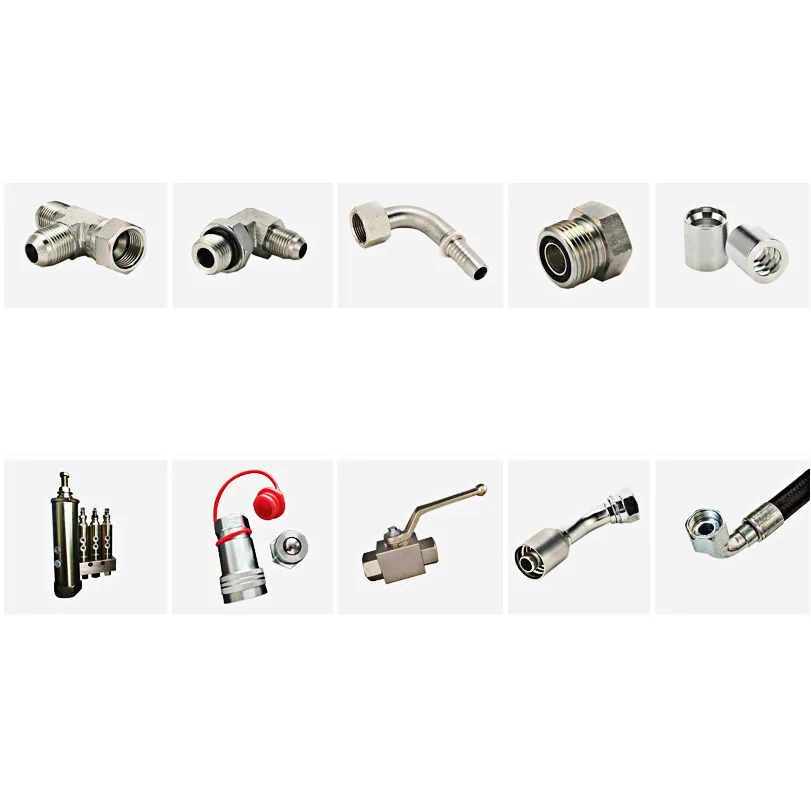335345435
Jun . 23, 2025 15:41 Back to list
Hydraulic Fittings for Sale: A Wholesaler’s Guide to Mastering Compatibility and Compliance
In the industrial supply chain, sourcing reliable hydraulic fittings for sale is essential for wholesalers aiming to support diverse hydraulic systems. From construction equipment to manufacturing machinery, the right fittings ensure leak-free operations and equipment longevity. Here’s a comprehensive roadmap to navigating material types, compatibility, and market demands—crafted to help you build a profitable, customer-centric inventory.

Hydraulic Fitting Types: Decoding Materials and Applications
When evaluating hydraulic fitting types, start with material composition: it dictates durability in high-pressure environments. Common materials include:
Carbon Steel: Cost-effective for general industrial use, often zinc-plated for corrosion resistance (ideal for 3000+ PSI systems).
Stainless Steel: Superior in corrosive settings (marine, food processing) or high-temperature applications (up to 500°F).
Brass: Suitable for low-pressure systems (under 1500 PSI) and potable water applications due to its non-toxic properties.
Case in point: A JIC (Joint Industry Council) fitting used in hydraulic excavators must withstand 5000 PSI and frequent vibrations. Suppliers who provide material certifications (e.g., ASTM A105 for carbon steel) and pressure test reports demonstrate reliability. Always verify that fittings match the hose’s working pressure and chemical compatibility to avoid catastrophic failures.
Different Types of Hydraulic Fittings: Catering to Diverse System Needs
Diversifying your inventory of different types of hydraulic fittings ensures you meet customer demands across industries. Key categories include:
Threaded Fittings: NPT (National Pipe Thread) and BSP (British Standard Pipe) are universal in industrial setups. NPT’s tapered threads create a tighter seal, while BSP parallel threads require sealants for leak prevention.
Flanged Fittings: Ideal for high-pressure, large-diameter systems (2"+). They distribute stress evenly, reducing the risk of hose blowouts in heavy machinery.
Quick-Connect Fittings: Critical for industries needing rapid hose changes (e.g., agriculture, construction). Look for designs with automatic shut-off valves to prevent fluid loss during disconnection.
Pro tip: Stock a 70/30 mix of standard fittings (NPT, JIC) and specialized types (flanged, quick-connect) to balance demand and inventory costs.
Hydraulic Hose Ends Types: Ensuring Seamless System Integration
Matching hydraulic hose ends types to system requirements is non-negotiable. Common end configurations include:
Crimp Fittings: Require specialized tools for installation, creating a permanent bond ideal for high-pressure applications. Ensure your supplier offers crimping dies compatible with popular hose brands (e.g., Parker, Eaton).
Clamp Fittings: Used with hose barb ends, suitable for low-pressure systems (under 500 PSI). Stainless steel clamps prevent rust in outdoor setups.
Welded Fittings: Found in custom hydraulic lines, requiring skilled labor for installation. Verify the supplier’s welding certifications (e.g., AWS D1.1) for structural integrity.
A mismatched hose end can cause leaks that damage equipment or create safety hazards. Always provide customers with installation guides or recommend professional crimping services to minimize errors.
Hyd Fitting Types: Sourcing Strategies for Wholesale Success
As a wholesaler of hyd fitting types, partnering with the right manufacturer is key. Look for suppliers like Dayi Rubber Products Co., Ltd., which offers:
In-House Testing: Computer-controlled hydrostatic testers and pulse tables ensure each fitting meets burst pressure standards (e.g., 4x working pressure for safety).
Certification Compliance: ISO 9001-certified production processes and MSHA approval for mining applications, critical for winning large-scale contracts.
Custom Solutions: Patented designs like anti-vibration fittings or corrosion-resistant coatings, allowing you to offer unique value to clients.
Bulk purchasing advantages (e.g., 10% discounts on orders over 500 units) can boost your margins, while bundled deals (fittings + hoses + clamps) attract customers seekingsolutions.
FAQ: Navigating Hydraulic Fitting Queries with Confidence
How do I match a hydraulic fitting to my hose’s pressure rating?
The fitting’s working pressure must equal or exceed the hose’s rating. For a hose rated at 4000 PSI, use fittings labeled for 4000 PSI or higher. Always check the supplier’s technical data sheet for compatibility.
Can I use brass fittings in a high-pressure hydraulic system?
Brass is suitable for low-pressure systems (<1500 PSI). For higher pressures, switch to carbon or stainless steel fittings to prevent thread stripping or body deformation.
What’s the best way to prevent leaks in hydraulic fittings?
Use Teflon tape or thread sealant on tapered threads (NPT), and ensure O-rings in face seal fittings are intact. Over-tightening can damage threads, so follow the manufacturer’s torque specifications (e.g., 30–40 ft-lbs for 3/8" NPT fittings).
How often should hydraulic fittings be inspected for wear?
Quarterly in industrial settings. Look for signs of corrosion, cracked O-rings, or loose threads. In mobile equipment (e.g., excavators), inspect before each use to prevent in-field failures.
Are there fittings approved for use in explosive environments?
Yes—seek fittings with ATEX (Europe) or NEC 500 (U.S.) certifications for hazardous locations. These fittings are designed to prevent sparks or contain explosions within the fitting body.
Build a Resilient Wholesale Business: The Fittings Factor
In the hydraulic supply chain, fittings are the unsung heroes of system reliability. By prioritizing material integrity, compatibility, and certification in your hydraulic fittings for sale strategy, you’ll position your business as a trusted partner for contractors, manufacturers, and fleet managers. Remember: a single faulty fitting can bring an entire operation to a halt—your clients depend on you to deliver solutions that keep them running.
Ready to transform your inventory? Collaborate with manufacturers who blend technical expertise (patented sealing designs, advanced testing) with industry compliance (ISO, MSHA). Your customers will appreciate the peace of mind, and your bottom line will reflect the value of quality fittings done right.
-
LPG Hose: Choosing the Right Hose for Safe, Reliable Gas Transfer
NewsAug.07,2025
-
Industrial Hose: Types, Applications, and Where to Find Reliable Suppliers
NewsAug.07,2025
-
Hydraulic Hose Pipe: Types, Pricing, and How to Source the Right One
NewsAug.07,2025
-
Hydraulic Fittings: Types, Customization, and Where to Source Them
NewsAug.07,2025
-
High Pressure Washer Hoses: Buying Guide, Specs, and Supplier Insights
NewsAug.07,2025
-
Choosing the Right Gasoline Hose: Flexibility, Resistance, and Supply Options
NewsAug.07,2025



